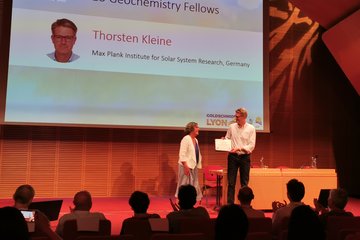Alle Typen
321.
Konferenzbeitrag
Heterodyne Instrument for FIRST (HIFI): Preliminary Design. In: The Physics and Chemistry of the Interstellar Medium, Abstract Book of the 3rd Cologne-Zermatt Symposium (Hg. Ossenkopf, V.). Shaker-Verlag Aachen (1998)
322.
Konferenzbeitrag
Comparison of MAS stratospheric ClO measurements with spaceborne, airborne, and ground-based experiments. In: Proceedings of the Quadrennial Ozone Symposium, S. 499 - 502. ANY PUBLISHER, L'Aquila, Italy (1998)
323.
Konferenzbeitrag
H2O in the Earth's atmosphere. In: Kleinheubacher Berichte, S. 186 - 193. (1998)
324.
Konferenzbeitrag
High resolution chirp transform spectrometer for middle atmospheric microwave sounding. In: Satellite Remote Sensing of Clouds and the Atmosphere II, S. 115 - 124 (Hg. Haigh, J. D.). ANY PUBLISHER, London (1998)
325.
Konferenzbeitrag
The MPAE dual channel heterodyne spectrometer. In: Proceedings of the 2nd ESA Workshop on Millimetre Wave Technology and Applications: Antennas, Circuits and Systems, S. 127 - 130 (Hg. Mallat, J.; Räisänen, A.; Tuovinen, J.). ESA Publ. Div., Espoo, Finland (1998)
326.
Konferenzbeitrag
A new microwave heterodyne spectrometer backend: The ASIC-CTS. In: Proceedings of the 2nd ESA Workshop on Millimetre Wave Technology and Applications: Antennas, Circuits and Systems, S. 333 - 338 (Hg. Mallat, J.; Räisänen, A.; Tuovinen, J.). MilliLab, ESPOO, Finland (1998)
327.
Konferenzbeitrag
Solar system research with microwaves. In: Proceedings of the 32nd ESLAB Symposium: Remote Sensing Methodology for Earth Observation and Planetary Exploration, S. 23 - 32 (Hg. Attema, E.; Schwehm, G.; Wilson, A.). ESA Publ. Div., Noordwijk (1998)
328.
Konferenzbeitrag
Analysis of forward models using the singular value decomposition algorithm. In: Satellite Remote Sensing of Clouds and the Atmosphere II, S. 163 - 173 (Hg. Haigh, J. D.). ANY PUBLISHER, London (1998)
329.
Konferenzbeitrag
Comparison of ozone profiles derived from ground-based microwave and lidar measurements. In: Microwave Remote Sensing of the Atmosphere and Environment, S. 202 - 209 (Hg. Wu, D. L.; Jin, Y.-Q.; Jiang, J.-S.). ANY PUBLISHER, Washington (1998)
330.
Konferenzbeitrag
Present and future Chirp transform spectrometers for microwave remote sensing. In: Sensors, Systems and Next-Generation Satellites, S. 328 - 339 (Hg. Fujisada, H.). SPIE, Washington (1997)
331.
Konferenzbeitrag
IF processing and backends: An optimised configuration for the HET instrument on FIRST. In: Proc. ESA Symp. ``The Far Infrared and Submillimeter Universe'', Grenoble, S. 413 - 416. ESA Publ. Div., Noordwijk (1997)
332.
Konferenzbeitrag
Limb sounding of water vapor and liquid water down to the troposphere. In: Proc. 6th Int. Symp. on Recent Advances in Microwave Technology, Beijing, S. 580 - 583 (Hg. Rawal, B. S.; Siyong, Z.). Publishing House of Electronics Industry, Beijing (1997)
333.
Konferenzbeitrag
Groundbased detection of middle atmospheric water vapor. In: Global Process Monitoring and Remote Sensing of Ocean and Sea Ice, EUROPTO-Series 2586, S. 188 - 195. SPIE, Bellingham (1995)
334.
Konferenzbeitrag
Groundbased microwave detection of middle atmospheric ozone. In: Global Process Monitoring and Remote Sensing of Ocean and Sea Ice, EUROPTO-Series 2586, S. 206 - 214. SPIE, Bellingham (1995)
335.
Konferenzbeitrag
A multiband chirp transform spectrometer for the microwave remote sensing of middle atmospheric trace gases. In: Advanced and Next Generation Satellites, EUROPTO-Series 2583, S. 282 - 289. SPIE, Bellingham (1995)
336.
Konferenzbeitrag
Retrieval of data from ground-based microwave sensing of the middle atmosphere: Comparison of two inversion techniques. In: Global Process Monitoring and Remote Sensing of Ocean and Sea Ice, EUROPTO-Series 2586, S. 196 - 205. SPIE, Bellingham (1995)
337.
Konferenzbeitrag
Millimeter wave detection of mesospheric ozone using a high resolution chirp transform spectrometer backend. In: Proc. IGARSS'94 on Surface and Atmospheric Remote Sensing: Technologies, Data Analysis and Interpretation, Pasadena, Vol. III, S. 3 - 5 (Hg. Stein, T. I.). Publ. Services IEEE, Piscataway, N. J. (1994)
338.
Konferenzbeitrag
Retrieval of mesospheric ozone from groundbased millimeter wave observations. In: Proc. IGARSS'94 on Surface and Atmospheric Remote Sensing: Technologies, Data Analysis and Interpretation, Pasadena, Vol. III, S. 1700 - 1702 (Hg. Stein, T. I.). Publ. Services IEEE, Piscataway, N. J. (1994)
339.
Konferenzbeitrag
Detection of stratospheric minor constituents using an airborne submillimeter wave sensor. In: Proceedings of the International Symposium on Environmental Sensing, S. 468 - 475. ANY PUBLISHER, Berlin, 22-26 June 1992 (1993)
340.
Konferenzbeitrag
A millimeterwave measurement system for atmospheric water vapour and ozone. In: Journal of the II. International Multidisciplinary Meeting on Environment. Editorial IDEARIUM, Mendoza, Argentina (1991)











